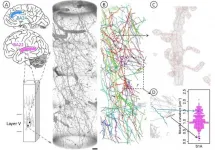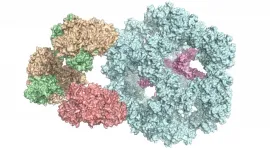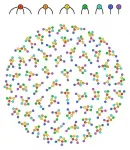(Press-News.org) JACKSONVILLE, Fla. (February 10, 2021) - Brain volume, verbal IQ, and overall IQ are lower in children with Type 1 diabetes (T1D) than in children without diabetes, according to a new longitudinal study published in Diabetes Care, a journal of the American Diabetes Association. The nearly eight-year study, led by Nelly Mauras, MD, a clinical research scientist at Nemours Children's Health System in Jacksonville, Florida, and Allan Reiss MD, a Professor at the Stanford University School of Medicine in California, compared brain scans of young children who have T1D with those of non-diabetic children to assess the extent to which glycemic exposure may adversely affect the developing brain.
"Our findings indicate that, despite improved glycemic control now possible with emerging technologies, individuals with T1D are at risk for cognitive dysfunction," said Mauras, principal investigator of the study, and Chief of the Division of Endocrinology, Diabetes & Metabolism at the Nemours Children's Health System in Jacksonville, Florida, and Professor of Pediatrics at the Mayo College of Medicine. "Our longitudinal data support the hypothesis that the brain is a target of diabetes complications in young children. Whether these changes can be reversed with scrupulous diabetes control requires further study."
The research team - from the Diabetes Research in Children Network (DirecNet), a multicenter National Institutes of Health-funded consortium - studied 144 children with T1D and 72 children without diabetes. Participating children had a median age of 7 years and average disease duration of 2.4 years when the study began. All study participants underwent structural magnetic resonance imaging (MRI) studies, as well as age-appropriate cognitive testing. In those with T1D, metabolic control was assessed using continuous glucose monitors (CGM) and hemoglobin A1C (HbA1C) testing. Over the eight-year study period, up to four MRIs were performed measuring white- and gray-matter volumes in various brain regions for all participants. In the T1D group, the research team assessed total cumulative hyperglycemic exposure since diagnosis.
The researchers found that total brain volume, gray- and white-matter volumes, overall IQ, and verbal IQ were lower in the diabetes group at 6, 8, 10, and 12 years, compared to controls. Differences at baseline persisted or increased over time, and brain volumes and cognitive scores declined as lifetime HbA1C index and higher sensor glucose rose.
"Although differences in cognition were mild - around 4 IQ points - this magnitude is similar to other conditions that affect the brain," said Mauras. "We know that T1D can cause complications in multiple organ systems, and our study adds knowledge to earlier research which suggested that glucose level variation in T1D can negatively affect brain development, beginning in childhood."
"It is truly important to follow-up on these results in two ways. The first is to study this and other populations of indiviudals with T1D into young adulthood to see if and how brain and cognitive issues affect long-term educational and vocational outcome. The second is to see if more rigorous early control of blood sugars can stop or even reverse the brain and cognitive effects we have observed in this study," said Reiss, co-principal investigator of the study and Robbins Professor and director, Division of Interdisciplinary Brain Sciences at the Stanford University School of Medicine.
Future research should examine whether improved diabetes control could possibly reverse the observed brain changes, and such studies also might follow individuals with T1D into young adulthood to see whether and how brain and cognitive issues affect long-term education and vocational outcomes.
INFORMATION:
The DirecNet consortium includes Nemours Children's Health System Jacksonville, Fla.; the Stanford University School of Medicine; Washington University, St Louis; University of Iowa; and Yale University.
This study was funded by the National Institute of Child Health and Development at the National Institutes of Health.
About Nemours Children's Health System
Nemours is an internationally recognized children's health system that owns and operates the Nemours Children's Specialty care in Jacksonville, FL, where the study was conducted, Nemours/Alfred I. duPont Hospital for Children in Wilmington, Del., and Nemours Children's Hospital in Orlando, Fla., along with outpatient facilities in six states, delivering pediatric primary, specialty and urgent care. Nemours also powers the world's most-visited website for information on the health of children and teens, KidsHealth.org and offers on-demand, online video patient visits through Nemours CareConnect.
Established as The Nemours Foundation through the legacy and philanthropy of Alfred I. duPont, Nemours provides pediatric clinical care, research, education, advocacy, and prevention programs to families in the communities it serves.
It was reported that volume of the brain areas such as superior temporal gyrus and anterior cingulate cortex reduces in schizophrenia but precise change of three-dimensional structure of neuron has remains unclear.
Dr. Itokawa and colleague performed Nanotomography experiments using Fresnel zone plate optics at the BL37XU beamline of the SPring-8 synchrotron radiation facility and at the 32-ID beamline of the Advanced Photon Source (APS) of Argonne National Laboratory.
A total of 34 three-dimensional image datasets of layer V of the BA22 cortex were blinded ...
The recent review, published in Environment International and led by the University of Tartu, summarises the effect of aquatic pollution on cancer prevalence in wild animals with the help of more than 300 reviewed studies. Authors shed light on understudied yet important fields in cancer research in wild animals - summarising the key effects and pointing to future research avenues to crack the puzzle of why cancer develops in polluted environments.
„What was immediately evident was the bias towards fish in current research into aquatic wildlife cancer. However, given this bias it is especially interesting ...
Sophia Antipolis, 10 February 2021: A nationwide US study has found increasing death rates from heart disease in women under 65. The research is published in European Heart Journal - Quality of Care and Clinical Outcomes, a journal of the European Society of Cardiology (ESC).1 The study found that while death rates from cancer declined every year between 1999 and 2018, after an initial drop, heart disease death rates have been rising since 2010.
"Young women in the US are becoming less healthy, which is now reversing prior improvements in heart disease deaths," said senior author Dr. Erin Michos of Johns Hopkins University School of Medicine, Baltimore, US. "With ...
Satellite images reveal that the timing of algal blooms in the Red Sea may affect the next haul of sardines and squid by commercial fisheries.
Rising temperatures in the Red Sea have changed the timing of phytoplankton blooms. These microscopic algae form the base of many marine food webs and so are critical to ocean biodiversity and the industries that they support on land, such as fisheries and tourism.
A team led by KAUST climate modeler Ibrahim Hoteit has used satellite images to study the phenology of algal blooms in the northern Red Sea and ...
A new method has enabled the natural structure of particularly large and complex enzymes to be revealed. Scientists at Martin Luther University Halle-Wittenberg (MLU) and TU Berlin have published their findings in the journal Cell Reports. They investigated a multi-enzyme complex that plays an essential role in metabolism and have discovered that it functions differently than previously thought. This will help scientists better understand certain diseases.
Enzymes are a cell's biocatalysts. They accelerate chemical reactions in the body or ensure that these reactions even take place at all. As a result, they play an extremely important role in metabolism. Individual enzymes frequently form a complex with many subunits, as in the case of the ...
In a study conducted at the University of Helsinki, Finland, 136 adults adhered to one of three study diets for 12 weeks. One of them corresponded to the average Finnish diet, containing roughly 70% animal-derived protein of total protein, while most of the plant-based protein originated from cereal products. In the second study diet, half of the protein was derived from plant products and the other half from animal products, while the third one contained 30% animal protein and 70% plant-based protein of total protein.
Sources of animal protein, both red and white meat as well as dairy products, were partially replaced with plant-based proteins by adding a diverse range of legumes, nuts, ...
Your breath holds the key to monitoring fat burning, and now a research group from Tohoku University has created a compact and low-cost device that can measure how our body metabolizes fat.
The device uses an ultraviolet lamp to gauge exhaled acetone gas, which is produced in the blood through the metabolic reaction of fat.
"Precise measurements of acetone gas concentration allows us to determine the body's ability to metabolize fat and develop exercise methods for efficient fat burning," says Professor Yuji Matsuura from Tohoku University's Graduate School of Biomedical ...
Many natural and human-made networks, such as computer, biological or social networks have a connectivity structure that critically shapes their behavior. The academic field of network science is concerned with analyzing such real-world complex networks and understanding how their structure influences their function or behavior. Examples are the vascular network of our bodies, the network of neurons in our brain, or the network of how an epidemic is spreading through a society.
The need for reliable null models
The analysis of such networks often focuses on finding interesting properties and features. For example, does the structure of a particular contact network help diseases spread ...
The research team led by Masakazu Ohara, graduate student of the Department of Computer Science and Engineering at Toyohashi University of Technology (student in the Leading Program doctoral program); Associate Professor Kowa Koida of the Electronics-Inspired Interdisciplinary Research Institute; and Associate Professor Juno Kim of the University of New South Wales (Australia) discovered that when people judge the thickness of an object, objects with glass-like transparent optical properties are perceived to be flatter than they actually are. It was previously known that objects made of metallic or glossy materials are perceived to be thicker than what they are, but now the current research has identified that transparent ...
A description of gravity compatible with the principles of quantum mechanics has long been a widely pursued goal in physics. Existing theories of this 'quantum gravity' often involve mathematical corrections to Heisenberg's Uncertainty Principle (HUP), which quantifies the inherent limits in the accuracy of any quantum measurement. These corrections arise when gravitational interactions are considered, leading to a 'Generalized Uncertainty Principle' (GUP). Two specific GUP models are often used: the first modifies the HUP with a linear correction, while the second introduces a quadratic one. Through new research published in EPJ C, Serena Giardino and Vincenzo ...





